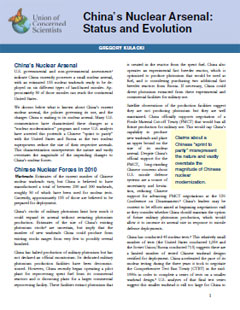China’s efforts to modernize its nuclear weapons arsenal are aimed at preserving a credible retaliatory threat, rather than signaling a shift toward a more aggressive nuclear posture, according to a new UCS report, China’s Nuclear Arsenal: Status and Evolution.
The report, authored by UCS senior analyst Gregory Kulacki, includes the following key findings:
- China’s nuclear arsenal is small, with an estimated 155 nuclear warheads ready to be deployed on six different types of land-based missiles, approximately 50 of which can reach the continental United States (by contrast, the U.S. has more than 1,700 warheads than can reach China).
- China’s nuclear weapons systems have evolved more slowly and on a smaller scale than those of the U.S. and Russia, in a manner consistent with a strategy based on convincing adversaries that China can retaliate effectively to a nuclear attack—thus deterring attacks and preventing nuclear coercion—rather than on the ability to inflict specific damage on enemy targets.
- Open-source publications show that China’s defense scientists and engineers see improvements in space and missile defense technology as the most significant challenge to the credibility of China’s retaliatory capability. Upgrades to China’s nuclear arsenal are focused on improving delivery systems to meet this challenge, and not on developing new offensive capabilities.
- China has halted production of military plutonium and decommissioned production facilities. A rapid expansion of its nuclear arsenal would require restarting military plutonium production, which would take time and would be observable.
- China has conducted only a small number of nuclear tests compared to the U.S. and Russia, which limits the number of warhead designs it can deploy. U.S. analyses suggest that China’s smallest tested warhead is too large to permit placing multiple warheads on long-range missiles.
While China's nuclear forces will play an increasingly important role as the United States and Russia continue to reduce their own arsenals, reliable evidence does not support the claim that China is attempting a "sprint to parity" with the two nuclear superpowers, as some U.S. commentators have suggested.




